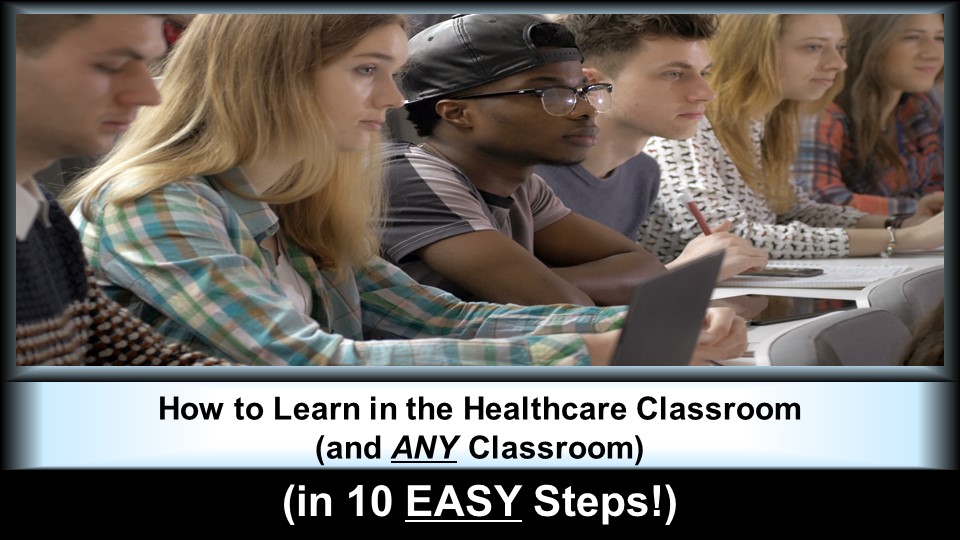
Imagine standing in front of your instructor on the day of your check-offs and your mind goes blank. Lucky for you, you memorized a shortcut to the procedure, closed your eyes, repeated it, and with confidence, you performed the task flawlessly. How did you get there? Here are 10 more ideas that can help, whether you are a healthcare student, a healthcare teacher, or you just want to improve your medical memory in other areas of your life. Improving your medical memory is important and can be incorporated into all areas of your life. We discussed 10 tips for improving your medical memory in Part 1. Now let’s look at 10 additional ways to improve your medical memory.
Know your learning style
The most basic step to learning how to have a perfect recall of the steps to your procedure is knowing how you learn. Are you tactile, auditory, or visual? Tactile learners need to write it down, make a model, or complete repetitive tasks to memorize topics. Auditory learners can listen to repetitive speech to understand their tasks. Visual learners use writings, graphs, charts, and other images to retain their information.
Rinse and Repeat
Unfortunately, one of the best ways for medical students to learn a procedure is to repeat it. As previously discussed in Part 1, this means either practicing the actual procedure, watching it done over and over, or listening to dictation to accomplish memorization. It takes some time to retain knowledge in long-term memory, and so must be done frequently and correctly.
Remember to Use Mnemonics
If you are an instructor, you can sometimes have an occasional lapse in memory when teaching. Luckily, you can improve your memory by teaching mnemonics to your students. For example, if you are a teacher, you can teach your students the ABCs of CPR. The ABCs of CPR are: Airway- Breathing- Circulation. If you are a student, this mnemonic is easy to remember and simple to recall.
Cheat Sheets
Your surgeon, before performing more complex procedures, reviews the procedures and how to perform them. Even the higher-level medical professional could use a written reminder, procedure book, or mental breakdown of procedures before performing them to enhance memory recall.
Rest
Not everything has to do with learning. Your brain will not retain all the information your medical career needs to be able to regurgitate without the proper care. Resting your brain allows it time to transfer the short-term cram session into long-term memory.
Don’t cram!
You will not do your brain any favors by not studying daily, doing repetitions, and learning everything you need to know just before the appointed time. Yes, you will be able to remember some things, but it will not be retained in your long-term memory and once you forget it- it is gone.
Teach others
Ironically, the best way to learn and retain medical knowledge is to teach it. A nurse may learn a better way to insert an IV when the student she observes performed the task slightly differently than the way she was instructed. This is an example of a “teachable moment” when mastering medical memorization techniques.
Take time to research
The more you know about a subject, the more your brain connects the dots and the easier it is to recall what you have learned. Find ways to make boring topics interesting, and your memory recall will improve.
Associate your medical topics with non-medical topics
If you are a tactile learner, you may make a routine out of a procedure. Once repeated, most of it becomes muscle memory. If you memorize by association, lab values can be associated with baking times, for example. Associating certain songs with a medical topic can help you remember medical information. For example, you could use a song rhythm to keep the beat when practicing CPR techniques.
Take the time to learn
Nothing is ever achieved overnight when it comes to practicing, teaching, or learning in the medical field. Even though everything is fast-paced, you need to take the time to learn and memorize your chosen tricks.
Learn your style, use the tricks and tips your instructor provides, or remember to review materials regularly before performing tasks. Follow the Avidity Medical Design Blog to learn more about many different areas of healthcare. Visit Avidity Medical Design Academy to enroll in a healthcare course to help you continue to broaden your fund of knowledge about many different healthcare subjects that you can use in everyday living.












